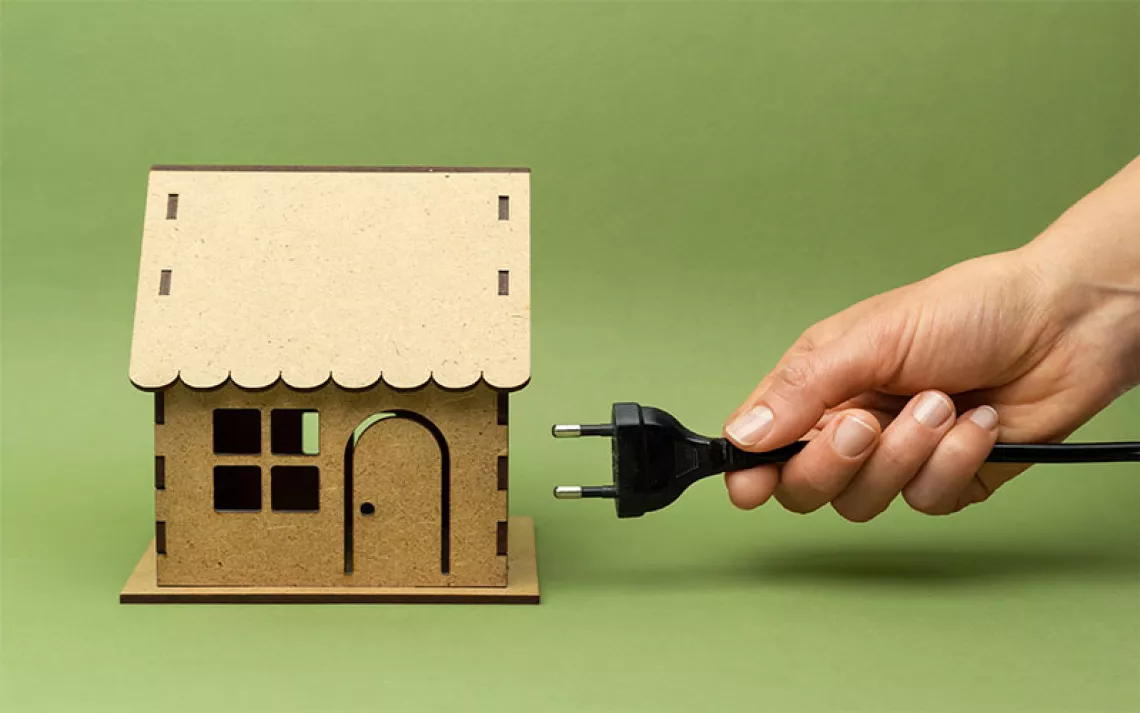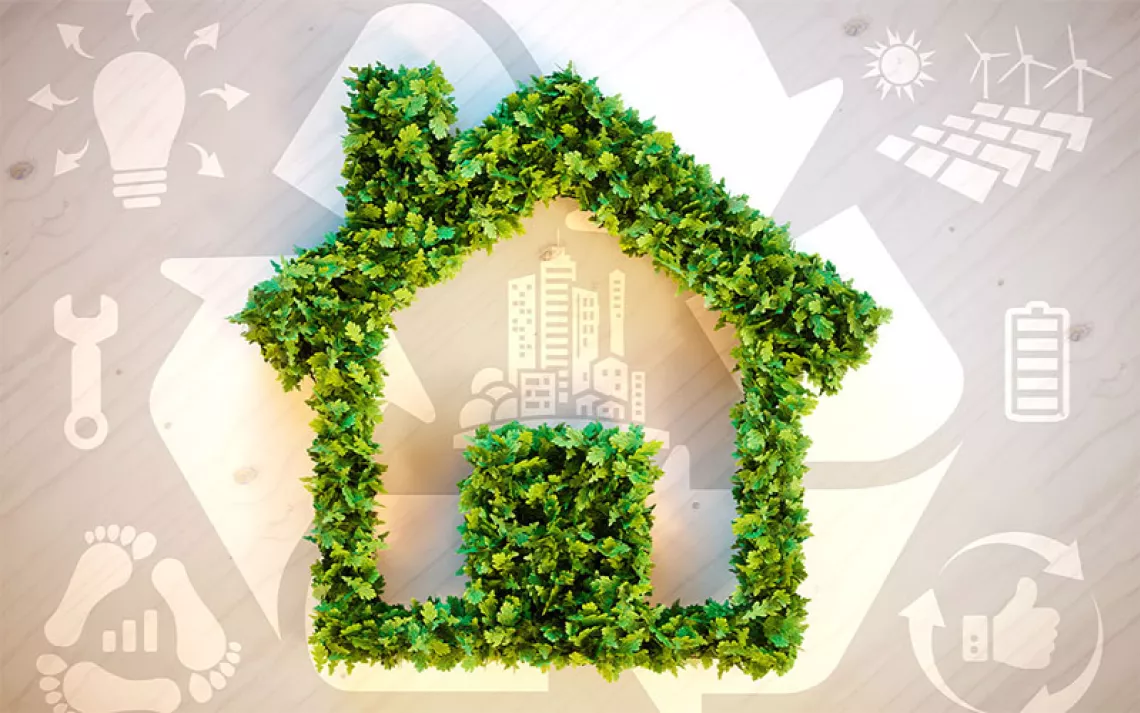Building Electrification Cuts Emissions as Cities Ditch Coal, Gas
Electrification movement grows as cities and states embrace renewable energy

Photo by graphicnoi/iStock
Across the United States, the impending climate catastrophe has pushed a broad coalition of communities to draft sustainability plans for a cleaner future. One of the common strategies these plans share is a major push for the electrification of buildings—when new and old buildings are outfitted or retrofitted with electric heating units and appliances instead of being powered by fossil fuels such as “natural” (fracked and conventional) gas.
Seattle has just enacted a ban on fossil fuels including fracked and conventional gas for new city-owned buildings and is committed to creating a plan by 2021 to retrofit city-owned buildings with electricity. New York City is committed to reducing greenhouse gas emissions by 80 percent of 2005 levels by the year 2050 under its 80 x 50 plan (electrification of buildings is a major part of the plan). Nearly 70 percent of greenhouse gas emissions in the city are attributable to powering, heating, and cooling buildings, primarily due to gas and oil usage.
Chicago is now the largest city to commit to transitioning to 100 percent clean, renewable electricity, with an additional commitment to electrifying all buildings by 2035.

Graphic courtesy of US Energy Information Administration, Monthly Energy Review, Table 7.2a, March 2019
Some states have also committed to electrification, with New Jersey planning to end fracked and conventional gas use in buildings by 2030 and new laws in Maine expected to enact a similar electrification plan. Meanwhile, eight states across the country have established 100 percent clean electricity goals—something that must go hand-in-hand with building electrification to achieve climate benefits.
While certain areas that have committed to producing and/or sourcing clean energy are set up for the benefits of electrification, the United States as a whole is not there yet, offering a much bleaker picture of how far we need to go as a country to fully heed climate scientists’ warnings.
Nationwide, as of 2017, electricity production emits nearly 28 percent of the nation’s GHG emissions, second only to transportation (over 60 percent of the nation's electricity comes from burning fossil fuels—mostly coal and gas). This means that in many areas, electrification will only serve the environment once electric production transitions away from fossil fuels.
Graphic courtesy of US Environmental Protection Agency (2019). Inventory of U.S. Greenhouse Gas Emissions and Sinks: 1990–2017
Since 1990, US GHG emissions from electricity fell by just 5 percent, which the EPA attributes to “lower- and non-emitting sources of electricity generation and an increase in end-use energy efficiency.” Across the US, coal still accounts for over 30 percent of the energy generated as of 2017, with fracked and conventional gas accounting for another 30 percent. Nuclear energy accounts for just over 20 percent, and renewable energy sources at just over 16 percent—including hydroelectric, biomass, wind, and solar.
While we have a long way to go as a nation, the country’s most populous state, California, offers a hopeful blueprint for the future.
“California’s grid is already clean enough to ensure that electrification would immediately reduce GHG emissions across all utility territories,” says a report by the deputy director of the Sierra Club’s Building Electrification Program, Rachel Golden. This makes the state an area where electrification can have huge benefits for resisting the impacts of climate change.
California has already surpassed its 2020 targets in the Global Warming Solutions Act of 2006 to reduce the state’s GHG emissions to 1990 levels by this year. But to meet its long-term 2050 targets of achieving a reduction in GHG emissions to 80 percent of 1990 levels, transitioning off all fossil fuels, including fracked and conventional gas, will be necessary.
GHG emissions from electricity generation in California is already down to 15 percent of the state’s GHG emissions overall—far under the national average—due to a large increase in renewable energy generation, according to the 2019 Greenhouse Gas Inventory by the California Air Resources Board. Notably, the inventory determined that for the first time California used more electricity from non-greenhouse-gas-emitting sources than from greenhouse-gas-emitting sources both for in-state generation and total generation (including imports) in 2017. For the study’s purposes, non-greenhouse-gas-emitting sources included hydroelectric, solar, wind, and nuclear energy—although hydroelectric and nuclear power have their own list of degradations to the environment.

Graphic courtesy of US Energy Information Administration, Monthly Energy Review, Table 7.2a, March 2019
Electric energy was once not considered "clean energy," due to its large contribution from coal and inefficiencies in the creation of electric energy. But that is now changing in areas across the US, such as California. In 2018, the state sourced less than 0.2 percent of its power generation from coal and was only second to Washington in renewable energy production, according to the EIA. That same year, renewable resources supplied nearly half of California’s energy generation, with solar energy alone providing around a fifth of the state’s total energy production—over 40 percent of US solar energy production, according to the EIA. This statistic includes hydroelectric power, which provided 13 percent of the state’s energy production that year. The rest of the energy was supplied by gas-fired power plants—providing over two-fifths of the state’s energy generation, while nuclear power’s contribution in the state declined from nearly 20 percent in 2011 to under 10 percent in 2018.
Over time, electrification’s positive impacts on the climate are expected to improve in California as the state has required a third of electricity retail sales to come from renewable resources by 2020, 60 percent by 2030, and 100 percent by 2045, according to the US Energy Information Administration.
Cities across California are entering the electrification movement. Through a plan beginning on the first of this year, Berkeley, California became the first city in the nation to impose an electrification ordinance on all new buildings—prohibiting the buildings from using gas.
“For years, Berkeley has recognized that gas use in buildings is a roadblock to achieving the city's climate goals, and has been working with the public and experts to craft a policy solution to reduce emissions in line with the climate crisis,” says Golden. “After over a year of public workshops and analysis, Berkeley identified restricting expansion of the gas system in new construction as the first step to curbing emissions, improving safety and air quality, and lowering the cost of new development.”
Not only were there no dissenting opinions at the public hearing for the ordinance, but the area's main gas supplier, PG&E, ended up publicly supporting it in Berkeley and in dozens of other cities in its service territory as “it recognizes the limited lifespan and high costs of gas as California moves toward a carbon neutral economy by 2045,” says Golden. PG&E joined a wide coalition of residents, academics, environmental advocates, builders, and the local utility provider East Bay Community Energy in support of the ordinance. In 2018, Berkeley switched its main energy provider from PG&E to East Bay Community Energy—which produces its electricity from solar, wind, and hydroelectric sources – assuring that the city’s transition into electricity will have a positive effect on the climate.

Graphic courtesy of Decarbonization of Heating Energy Use in California Buildings: Technology, Markets, Impacts, and Policy Solutions
From its start in Berkeley, California, the move toward electrification has now pushed to over 25 cities and counties across California adopting standards requiring or strongly supporting the electrification of new buildings in their communities, with over 50 cities and counties in the state actively considering similar ordinances to the ones passed in Berkeley.
One of these cities is Los Angeles, which debuted its 2019 sustainability plan outlining its commitment to have new buildings be zero-emission by 2030 and retrofitting existing buildings to be zero-emission by 2050. The city has already abandoned multibillion-dollar plans to rebuild three gas power plants.
But unlike the ordinance in Berkeley, the push for electrification hasn’t been met without resistance elsewhere. SoCalGas, the only major utility in California that sells solely fracked and conventional gas to areas across Southern California including Los Angeles, has become one of the biggest opponents of this movement in California. The company created a front group called Californians for Balanced Energy Solutions and tried to have both itself and the front group represented in California Public Utilities Commission proceedings regarding the future of fracked and conventional gas in California. Under pressure from environmental organizations including Earthjustice and the Sierra Club, Californians for Balanced Energy Solutions withdrew from the proceedings and the group is now discredited, notes Golden. SoCalGas did not respond to repeated request for comment on this.
As electrification takes hold, gas companies are pitching fracked and conventional gas alternatives to save their companies’ profitability. SoCalGas and other companies are touting what they call “renewable natural gas,” an industry spin for fuels such as biomethane. Biomethane can be derived from organic waste such as cow manure, agriculture, gas from landfills, and sewage waste—capturing methane that may otherwise be released into the atmosphere. But renewable energy advocates say the research is clear—these fuel sources are neither scalable nor will they be affordable without making significant investments that will postpone the transition to cleaner energy. Even if biomethane were to be captured from all organic waste sources throughout California, it would only meet about 3 percent of the state’s demand for gas—meaning that the majority of the gas supply would still be fracked and conventional gas.
Green energy advocates argue that sourcing biomethane still contributes to environmental and air-quality problems while profiting off of environmental justice abuses—and emphasize that it is not an alternative to building electrification. Sourcing biomethane from factory farms and landfills profits off of a long history of environmental racism and environmental justice issues as these industries are disproportionately located in minority and low-income communities—subjecting residents to a slew of health risks, as noted in studies published by the EPA and the National Institute of Health. For biomethane to become a viable fuel source in the state, these water and air-polluting facilities would have to expand.
Along with the effects of gas on the environment, effects on the consumer must be taken into account. While prices and availability vary depending on region, and despite the high efficiency of electric heating, gas heating is often still the cheaper alternative to electric heating in the US. But, studies show that over time this is set to change—over the course of the next 20 years, the average household will experience a decrease in their energy bill by $4,000 to $10,000 through electrification as gas begins to be phased out in areas throughout the United States.
While direct costs through power usage may be lower in most areas throughout the US for now, gas usage can also come with health costs to the end user. The LA basin and Central Valley of California hold some of the worst levels of air pollution in the country, with building gas combustion producing six times as much nitrogen oxide pollution as all of the state’s power plants, according to the National Resources Defense Council. Additionally, gas stoves are a major cause of indoor air quality problems—producing nitrogen oxide, carbon monoxide, and formaldehyde in the home. A study led by Berkeley Lab scientist Jennifer Logue noted that health consequences of poor indoor air quality are “as significant as those from all traffic accidents or infectious diseases in the United States,” with another study by Logue showing that 60 percent of California homes cooking at least once a week with a gas stove could be subject to levels of pollutants that outside would be illegal.
As low-income individuals and minority communities are often disproportionately affected by environmental pollution, electrification is one important step to protect these areas. California is investing directly in communities, such as the San Joaquin Valley—which the EPA notes has some of the worst air pollution in the nation—to fund electrification pilot programs for low-income households.
“This is direly needed to improve air quality, safety, and affordability for those at the front lines of the climate crisis,” says Golden.
 The Magazine of The Sierra Club
The Magazine of The Sierra Club



